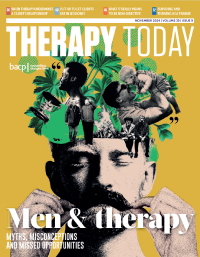'We’re known by a 21-year-old practical joke.’ I’m on the phone to Dr Zac Seidler, clinical psychologist and Global Director of Men’s Health Research at Movember. It strikes me how fitting the origins of this now billiondollar philanthropic organisation are. It may have been born out of banter and be synonymous with growing comedy moustaches, but from the start its motivations have been deadly serious. Sometimes what is obvious about a thing can disguise its depth and potential.
In the spirit of Movember, I talked to therapists, researchers and campaigners about ways in which mental health services need to adapt to better meet the needs of male clients. A recurring theme is that there are prevalent misconceptions about male engagement with therapy, about male presentations of distress, and about men and boys in general. Most therapists are probably aware of the bleak statistics around men’s mental health, but are we looking closely enough at the reasons why they exist and how we can better address them?
Adapting
Seidler is particularly interested in how we can change systems to better meet men’s needs. ‘We need to understand how to reach, respond and retain them in care, moving away from a narrative that men just need to adapt to a healthcare system that is not actually built with them in mind,’ he says.
75% of deaths by suicide are males, and they are three times more likely to die by suicide than women
This is a key issue – as therapists, what we often expect from men runs in opposition to the conditioning they have received throughout their lives. ‘There is an inherent desire in many therapists for open vulnerability and emotional communication which is fundamentally contradictory to masculine socialisation,’ says Seidler. ‘A framework of care that is at odds with the way in which men and boys are brought up to describe and express what’s happening for them.’
Movember was initially focused around prostate and testicular cancers, but since 2003 it has grown to include work around mental health and suicide prevention. ‘Sixty per cent of men who die by suicide have been in touch with the mental health system or other services in the year prior,’ says Seidler. ‘The idea that everything happens out of the blue is incorrect – there is contact, there is willingness, openness and motivation for change. It is up to the workforce and the system at large to start to consider how it sets men up to fail and then blames them for it.’
Read this issue
Socialisation
While responsibility for breaking down the barriers to men engaging well with therapy certainly lies within the counselling profession and service providers, as well as within men themselves, we also need to accept the wider systemic context. This may require us to focus on the subtle ways in which male socialisation can impact our clients.
I spoke to Dr Dwight Turner about his experiences of working with male clients. ‘At the very least there is an awareness that something is wrong and that they need to speak up and speak out about their experiences, and at the other end there is a willingness to engage with what it is to be a man,’ he says. ‘I’ve found in doing work with men over the past 20 years or so, I am encountering men who have hidden behind the stereotype and found it doesn’t work for them anymore. And in rediscovering their gentleness or just that they are very kind, friendly men, they have discovered more of themselves and gone on to live some pretty well-fulfilled lives.’
He adds: ‘Men are realising that they have been co-opted into a way of being that has led to problems with mental health and so on. As they start to stretch beyond those systemic boundaries and rediscover what it is for them to be men – be they men of colour, be they men from the LGBTQ+ community, whoever they might be – they start to stride out and become their own types of men, broadening out masculinity.’

Dr Zac Seidler
Limited masculinity
A theme, however, that comes through from many who work in this area is that, despite increased public awareness campaigns, there are few spaces where men can ask questions about what it is to be a man. I spoke to Dr Georgia Philip, Lecturer in Social Work and Sociology at the University of East Anglia (UEA) who, along with colleagues, has carried out two longitudinal, qualitative studies of fathers involved in child protection and in local authority care proceedings, each involving talking with fathers over the course of a year. The result was a collection of ‘powerful, challenging and humbling’ narratives that, alongside the usual academic reports and papers, were used to create composite characters for a play called How’s Your Father?, written by Simon Floyd in conjunction with UEA and the campaigning organisation Dads Matter. The play toured local authority social work teams in Norfolk, Suffolk and Essex as a way of developing practice with fathers.
Although the study had a social care focus, Philip told me that participants revealed much about their struggles with mental health issues and the service response they received. ‘The profiles of the mums and the dads involved in care proceedings are actually very similar. They are often younger, they have had very harmful early lives, they are experiencing mental health issues and there may be substance abuse. So they are similar, but those things are interpreted differently for women and men in that situation. For women they are seen as vulnerabilities and therefore as needs, but for men they are interpreted much more as risks, and therefore the pathway and service response is different. I think that is really problematic.’
Philip also questioned whether we need to treat men as a service user group that requires specialist training, or whether instead we need to adjust our perceptions of male clients so that we can appropriately apply our existing skills. She identified that often care professionals had ‘less confidence and willingness to work with men and hold the tension between both the potential they have and the problems or dangers they may pose’.
One consequence of this lack of confidence in professionals was a sense in male service participants of ‘not knowing how to be’. If they became emotional, they were viewed as ‘too difficult’, but if they stayed quiet, they were perceived as unco-operative or uncaring.
32% of men offered treatment by NHS Talking Therapies will not complete their allocated sessions
In the context of parenting, men are also consistently seen as secondary – another deeply embedded stereotype related to gender and care. This creates a problem in two directions, in that fathers are often not held accountable to the same degree as mothers, yet nor are they validated or supported as parents in their own right. In other words, their privilege can serve to other them when the context changes.

Dr Georgia Philip
Privilege
Another ongoing area of development in our profession, says Turner, is awareness of the impact of intersectionality in clients, including men. ‘There is always a danger in placing privilege or otherness on one homogenous group as opposed to another because it takes us away from actually looking at what the individual experience is like for people within those groups. Who are they really, beyond these sorts of labels?
‘There is this common perception that if you are the man, then you have all the privilege in society, which makes it very binary. It’s not as simple as that. I work with men around this and they find themselves othered into playing out a role or being seen as only one way of being. Actually, what often comes up when you take a more intersectional lens into their identities as men, and as many other things, is that there may be one area in which they hold privilege, but there are many other areas where they don’t. Only by acknowledging the fullness of our human experience do we then start to recover who we are. When a person is seen as having male privilege, we sort of deny that they have a story to tell about that experience.’
Narratives
If we are to allow our clients the space to engage with what masculinity means to them, we may first need to challenge some of the prevailing narratives around masculinity. There is no doubt that feminism has changed our sector and society at large for the better – I believe that our practices and our clients’ experiences have benefitted significantly from feminist insight, and on the whole it has made psychotherapy far more inclusive and equitable. Efforts to tackle male aggression and violence are ongoing and fundamental to ensuring safety within our society. An unfortunate outcome of these efforts, however, is that masculinity has become synonymous with the word ‘toxic’. Seidler describes this as ‘reductive and often stigmatising language’: ‘There are plenty of things about traditional masculinity that I believe are toxic. There is a difference between saying that and putting a descriptor in front of masculinity – it is stifling, and it ends up becoming a self-fulfilling prophecy.’

Dr Dwight Turner
Role models
Alongside challenging our own assumptions about our male clients, it is essential that men are offered modelling of healthy masculinity. I spoke to therapist and author Joshua Fletcher about ‘owning’ his mental health issues publicly. Through his use of social media Fletcher has been able to use self-disclosure to model authenticity. ‘If they see me, a confident, funny, accessible person who is doing OK after not doing OK, people who can relate to what I’ve been through find that inspiring,’ he says.
Many of our male clients will not have had vulnerability modelled to them, and yet it is what we are expecting of them. Fletcher summed up his experiences at school as ‘if you cried, you would get beaten up’. Within the male socialisation he experienced, vulnerability posed a significant risk to social status and safety. He soon learned that the ‘consequences of emotional processing’ were negative.
He told me that many men who contact him want to ‘test the waters to see if I’m legit’ in response to him presenting a different type of male role model. His self-disclosure offers men ‘evidence of improvement’ through therapy, and answers the question, ‘If I talk does this lead to good places?’
As therapists we may take for granted the route between talking and mental health benefits but for many male clients, socialised to mistrust emotional vulnerability, they may question why that would work.
‘If I can conceptualise me talking about stuff, opening up, as a step towards fixing myself and feeling better, then I’m more likely to do it,’ says Fletcher. ‘As opposed to every year simply being told it’s OK to talk, it’s OK to open up. Why? Why does that benefit me? I think a lot of men need to know why it is good.’
This approach acknowledges the common desire among men to solve problems, to fix things, to do rather than to be. Instead of challenging their existing way of being, it moves towards it.

Joshua Fletcher
Creating space
Research by Georgia Philip and her team at UEA confirms what many practitioners know from experience – it’s a myth that men don’t talk. As she says, ‘They do if space is created.’
So how can we create this space effectively? If we want to contribute to undermining the existing, limiting socialisation of men, we may need to first accept it in clients and move towards where we find them. This often means both metaphorically and physically.
I spoke to Nick Little, Director of 12th Man, a campaigning group to help men talk about mental health. From his experiences working in mental health services, he came to recognise that ‘a lot of the events we were setting up, we wouldn’t come to’.
Through talking to hundreds of men about their mental health it became clear that men often preferred a more doing rather than being approach. ‘It’s about doing an activity, and the last activity that they seem to want to do is to go into a room that is set up with two chairs and start talking about their feelings. But get them to ride a bike together and after 20 miles they are talking. Go for a haircut and they’re talking,’ he says.
12th Man creates links with spaces where men already congregate, such as barbers, gyms, working men’s clubs and tattoo parlours, and provide mental health first aid training to staff at these venues. Little told me that his focus was less on crisis though and more on ‘trying to make mental health part of everyday conversation’. On the ground, this means encouraging men to discuss ways to maintain positive mental health.
36% of all NHS referrals for psychological therapies are for men
Traditional responses have been to normalise crisis by focusing on getting men to seek help when they are at risk. Little says that 12th Man’s approach differs from this: ‘One in four people at any given time is experiencing a mental health problem, but three in four people aren’t. They all have “mental health” as well, they are either in a good place, an average place or starting to move towards being the one in four. They are completely ignored in the way mental health is talked about, and that, we think, is a significant problem.’
Although not a sports charity, the name comes from football – that when a team is struggling on the pitch, a supportive crowd of fans can act like a ‘12th man’ to the team, and ‘turn everything on its head’. Values of unconditional support, loyalty and expression of emotion are all available to men within this environment. Little describes the ‘elevated status’ of a man crying at a match because it is seen as passion and commitment rather than weakness.
So perhaps one way of approaching the problem at hand is to try and identify ways in which masculine socialisation can work in our favour? Seidler emphasises the importance of recognising and building on the positive aspects of masculinity that already exist, the ‘skills and strengths and abilities that are deemed unnecessary or unimportant rather than trying to leverage those to our advantage’.

Christian Chalfont
Groupwork
Men are social and respond to the behaviour of those around them just as much as anyone else. Another way in which healthy masculinity can be modelled to people in real life is within a group environment. Christian Chalfont runs Men's Retreats UK, an organisation that seeks to help men ‘caught in limbo between who they think they should be, and who they really are’.
‘We don’t intellectualise what guys are going through, and we very much speak from our own lived experience. We model that vulnerability and how to witness and receive each other without the need to diffuse the situation with banter or diminish what someone is going through. We are not offering advice or trying to fix somebody, we just teach men presence and silence, and that is enough. Simply to be here and witness one another without the need to have a solution,’ says Chalfont.
‘This is a platform where they are just tentatively trying something which isn’t as confronting as one-on-one stuff. They might not end up sharing that much through the weekend but as soon as they see other men sharing from a place of modelled vulnerability and appropriate behaviour, they always respond in kind. Once they can see that level of acceptance, that humanity, that mature masculinity that we bring to something, then that allows them to consider other options.’
This actively counters the socially constructed notion among men that ‘reliance on others admits defeat and failure’, and allows participants to engage in the ‘full spectrum of experience’. Talk About It Mate is another organisation using groupwork to help male clients. The social enterprise was started by BACP registered therapist Mike Richard and runs three men’s groups a week in Salford. Richard is passionate about getting men from different backgrounds into therapy and told me, ‘counselling can learn a lot from peer support’.
‘Loads of aspects of masculinity are great. Helping others and being part of a team, when you tap into that the guys feel very connected with each other. They are more likely to achieve their individual goals when they are part of a supportive group. We are missing out on giving these guys what they deserve. They can take the skills that we give them and the knock-on effect is that it helps their families, their wives, their children,’ says Richard. ‘I just think that if we hold back on the knowledge we have as counsellors, that’s such a shame isn’t it? If they can’t access it because they can’t afford it we have to be creative in the ways that we get that knowledge across.’
40% of men won’t talk to anyone about their mental health

Mike Richard
Action
Twenty years ago, the social critic and scholar bell hooks wrote that the ‘feminist movement created a socially sanctioned space where girls can create a sense of self that is distinct from sexist definition; the same freedom has not been extended to boys’.1 Through talking to the people who have generously contributed to this article I have learned about some of the spaces where this is currently possible for men. But there is still work to do. These spaces need to be amplified and replicated.
We find ourselves currently in what Seidler calls a ‘complex inflection point’. If our men and boys have nowhere to turn for this form of expression, the loudest voices from the manosphere, offering simple solutions to complex problems, will win out. Seidler calls this ‘make or break from a social cohesion perspective’ and says that it is ‘on the care workforce to be a connector, not a disruptor here’.
I asked Seidler what Movember’s answer was. ‘Go to where men are and try to co-design solutions. We don’t talk at men, we talk with men,’ he says. ‘You need to be willing to listen to all opinions, you need to not offer confirmation bias. My call-out constantly to counsellors and therapists is to find ways to challenge the orthodoxy, to consider the notion of best practice and what is actually working. Try to engender a room and a space that allows for honesty and transparency in response.’
If we want to encourage a broader change of narrative around masculinity then a good place to start is within our existing skills base. We can listen to our male clients. We can find out what their particular experience of masculinity is. We can attempt to move beyond common perceptions of it as simply ‘toxic’.
If male clients feel unable to be honest and transparent in response to us, we may have already lost them. ‘That’s the greatest risk here,’ says Seidler. ‘Disconnection and detachment. My main aim across the board is to find ways to call men in, not call men out.’

Nick Little
References
1. hooks b. The will to change: men, masculinity, and love. Washington: Washington Square Press; 2004.

